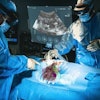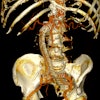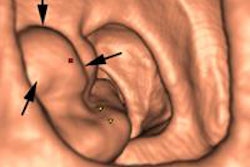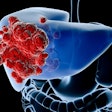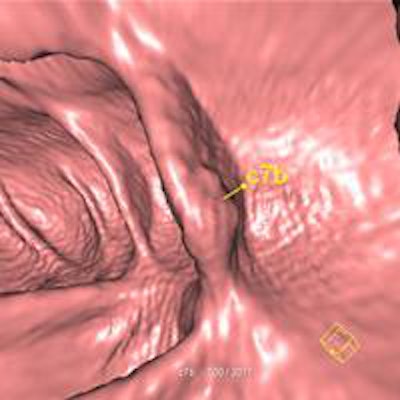
In one of the first studies to look at moderately experienced readers rather than experts or novices, computer-aided detection (CAD) significantly improved polyp detection sensitivity at CT colonography (CTC), according to a new study in European Radiology.
Among the seven intermediate readers looking at 70 datasets, 86% improved with the use of CAD as a second reader, while 71% achieved higher accuracy for polyp detection when CAD was used concurrently, reported the study team from the Medical University of Vienna in cooperation with several U.S. academic centers. Areas under the curve (AUC), as well as sensitivities were significantly higher per colonic segment, per patient, and per polyp with the use of CAD, the authors reported.
Meanwhile, specificities dropped slightly with the use of CAD, reflecting a few additional false-positive detections, wrote Dr. Thomas Mang from the Medical University of Vienna, Dr. Luca Bogoni, and colleagues from the University of Pennsylvania and Temple University, both in Philadelphia, Wake Forest University in Winston-Salem, NC, and other institutions (European Radiology, 10 May 2014).
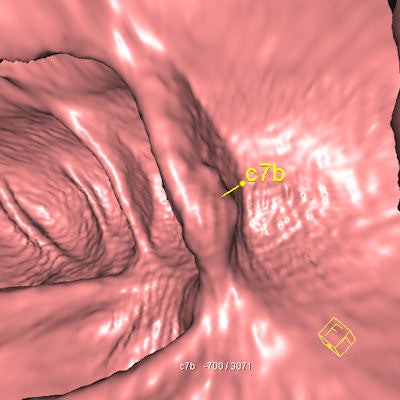 Flat polyp (11 mm) in the ascending colon shown with a CAD marker. CAD helped 5/7 readers to detect this lesion. Also, 2/7 readers detected the lesion already in the unassisted read. Image courtesy of Dr. Thomas Mang.
Flat polyp (11 mm) in the ascending colon shown with a CAD marker. CAD helped 5/7 readers to detect this lesion. Also, 2/7 readers detected the lesion already in the unassisted read. Image courtesy of Dr. Thomas Mang."CAD as a second reader has been shown to increase radiologists' performance in several studies and this has been more apparent for nonexpert than for expert readers," Mang told AuntMinnieEurope.com in an email. "However, radiologists highly experienced in CTC reportedly achieve high sensitivities and specificities even without CAD. Readers who lack prior CTC experience may profit from dedicated training in CTC before beginning reviewing CTC studies."
The training helps in correctly interpreting CTC studies, identifying colonic lesions, and rejecting findings that mimic colonic polyps, according to Mang. But even though moderately experienced readers may read at lower sensitivities than highly experienced readers, "They have the potential to correctly interpret CAD results, and thus benefit from using CAD," he wrote. "This group may also represent a substantial fraction of CTC readers, given CTC growing practice."
Applied as a second reader after a full review without assistance, CAD has been shown to increase the detection of polyps 6 mm and larger significantly compared with no CAD, according to Mang.
In this study, the data were read by seven radiologists with moderate experience levels; all of the readers had from 2.5 to 6 years of clinical experience with CTC, and six of seven had passed a CTC training course consisting of at least 50 cases. For the study they examined 66 colonoscopy-confirmed polyps larger than 6 mm in a group of 70 patients (34 with polyps).
The first read was done unaided, then performed again after CAD was activated. Four weeks later, a third read took place with concurrent CAD assistance. The readers were allowed to use a primary 3D or 2D technique as they preferred in clinical practice.
CTC scheme
The study group used a prototype of a commercially available CAD algorithm (Syngo CT colonography, version 04.06, Siemens Healthcare) to precompute the CAD marks, which they preloaded on the CTC application and gave to each reader. Unlike some other CAD systems, this application does not allow the user to adjust between sensitivity and specificity, Mang and colleagues noted.
Overall, six of the seven readers improved with the use of CAD as a second reader, while five achieved higher accuracy for polyp detection when CAD was used concurrently. Sensitivities were also higher per colonic segment, per patient, and per polyp with the use of CAD (p < 0.001), the authors wrote. Meanwhile, specificities dropped slightly with the use of CAD, reflecting a few additional false-positive detections.
Working alone, the CAD algorithm demonstrated 100% per-patient sensitivity for lesions 6 mm and larger. On a per-polyp basis, CAD found 19 of 21 polyps 10 mm and larger and 39 of 45 polyps 6 mm and larger for a per-polyp sensitivity of 90.5% for lesions 10 mm and larger, and 86.7% for lesions 6 mm and larger, the group wrote. The mean false-positive rate per patient was 4.26.
The average AUC was 0.781 for the unassisted read, 0.853 for the CAD second read, and 0.864 for the CAD concurrent read (p < 0.001), with all seven readers improving significantly with the use of CAD concurrently and as a second reader, the study team wrote.
The seven readers' average segment-level specificity without the use of CAD was 0.972; it decreased to 0.965 when CAD was used as a second reader (p = 0.005). However, the readers' average segment-level specificity was the same without CAD and when using CAD concurrently (p = 0.933). Finally, the readers' segment-level specificities with CAD as a second reader (0.965) versus CAD used concurrently (0.972) did not differ significantly (p = 0.134), Mang and colleagues wrote.
As for false-positives, the average number of false-positive findings per patient (both large and diminutive polyps) was 0.28 with CAD, increasing to 0.40 when CAD was used as a second reader -- and decreased to 0.26 when CAD was used concurrently. Most were easily identified as false-positives by the reader, while a few were wrongly accepted as true-positives, the authors wrote.
But the low number of false-positive findings was a strong point of this study. Most studies have concluded that CAD as a second reader improves sensitivity. However, very few have shown that they did so without a significant drop in specificity, as this study did, the authors wrote.
"There was a small difference in the false-positives, yet this difference was not significant, specifically when excluding diminutive false-positives," Mang explained in his email. "With respect to the decrease in specificity, we reported a decrease when CAD was used as a second-reader compared with an unassisted read and this is consistent with previous research. We hypothesize that this difference might be related to the longer reading time and the double evaluation in the second-read paradigm.
"Specifically, after completing the unaided read, reviewing findings proposed by CAD may introduce confounding factors or reconsiderations. On the other hand, we did not notice such a decrease in the CAD concurrent read. A possible explanation could be a bias of the reader toward the CAD-marked findings and this could also decrease the readers' confidence for nonprompted colonic areas."
CAD increased reading time by two to six minutes when CAD was used as a second reader, but not when CAD was used concurrently.
The authors concluded that CAD use significantly improved the per-patient, per-polyp, and per-segment sensitivity of radiologists with moderate experience in CTC.
"We are using CAD for CTC in daily clinical practice for almost all CTC studies," Mang wrote.


